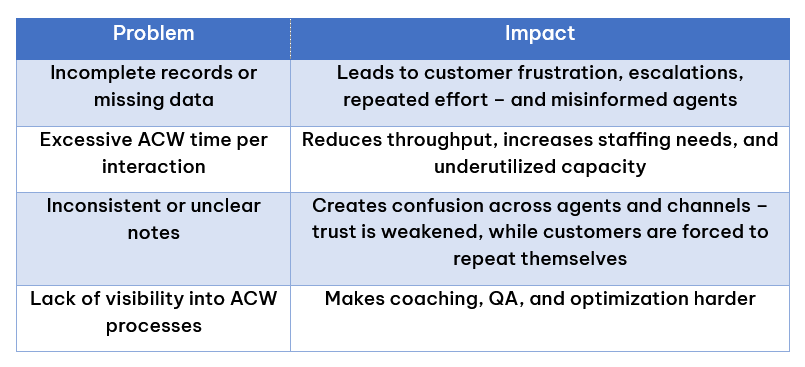

Tech Terms: After-Call Work (ACW)
In contact centers, the call isn’t the end of the interaction. It is the turning point.
What happens after the conversation wraps up can shape everything that follows – from resolution quality to customer trust, from agent productivity to CX outcomes.
Why the End of the Call is Just the Beginning
After-Call Work (ACW) is more than just administrative wrap-up. It is the crucial bridge between a customer interaction and what your brand does next.
When optimized, ACW enables faster resolutions, stronger data continuity, and higher efficiency across your operations.
But when ACW is slow, manual, or inconsistent? It becomes a hidden drain on agent performance and customer satisfaction.
That’s why leading contact centers are rethinking ACW – not as an afterthought, but as a strategic driver of CX and operational excellence.
So, what is After-Call Work – and why does it matter more than ever?
What is After-Call Work (ACW)?
After-Call Work refers to the series of tasks that an agent completes immediately after finishing a customer interaction. These tasks often include:
- Updating account records
- Writing case notes
- Assigning follow-ups or escalations
- Tagging conversation topics or interaction outcomes
- Completing CRM workflows
ACW helps to preserve continuity between interactions. It ensures that the next agent – or the next system – knows what happened and what needs to happen next.
In short? ACW is how your contact center “remembers” the interaction.
Why ACW Deserves Strategic Focus
After-Call Work (ACW) doesn’t just impact the back end of your contact center. It directly shapes key performance indicators (KPIs) across your operation – and your customer experience.
Here’s why optimizing ACW matters:
- It Impacts Customer Satisfaction (CSAT). Clean, consistent notes mean customers don’t have to repeat themselves. That builds trust and accelerates resolution.
- It Affects Agent Productivity. The longer ACW takes, the fewer customer contacts an agent can handle during a shift. Manual processes create inefficiencies and burnout.
- It Shapes Key Metrics. Average Handle Time (AHT), First Contact Resolution (FCR), and even Net Promoter Score (NPS) can all be influenced by poor, or delayed, ACW.
- It Drives Operational Costs. ACW directly impacts labor utilization, tech stack efficiency, and workflow bottlenecks – all major cost levers across your contact center.
The Hidden Cost of Poor ACW
When ACW isn’t optimized, it becomes a silent performance killer:
Most of these issues don’t show up in dashboards – until the issues snowball into customer churn or agent attrition.
What Does Efficient ACW Look Like?
So, what does good look like across ACW? Organizations that treat ACW as a strategic CX lever focus on these key outcomes:
- Fast Wrap-Up. Agent complete post-call tasks quickly and are able to return to availability faster.
- Structured, Accurate Documentation. Notes follow a consistent format, capturing all key details of the interaction.
- Automation of Repetitive Tasks. AI handles common post-call steps, like tagging, transcription, and summarization.
- Workflow Integration. ACW feeds directly into CRM, ticketing, and analytics platforms.
- Visibility and Optimization. Supervisors monitor ACW time and intervene, where needed.
Done right, ACW becomes part of of a scalable, intelligence, and customer-friendly operation.
How ElevateAI Helps You Reduce After-Call Work, Intelligently
At ElevateAI, we design tools that reduce the After-Call Work (ACW) burden without sacrificing quality or context. Our GenAI-driven feature suite automates the repetitive while amplifying what matters.
The ElevateAI product suite supports efficient ACW by delivering:
- Our Purpose-Built Generative AI Feature Suite. Auto-generate call summaries, recommend follow-ups, and complete structured notes – instantly and accurately.
- Real-Time and Post-Call Transcription. Capture every word of your customer interactions with speaker separation and punctuated transcripts. No more relistening.
- Workflow Automation. Automatically trigger CRM updates, escalations, and ticket routing, based on call outcomes or flagged keywords.
- CX-Aware Language Models. Our models are built for contact center use, ensuring context-aware, brand-aligned output.
- Supervisory Dashboards. Use ElevateAI Explore to track ACW time by agent, by team, or by queue. Identify trends. Surface coaching opportunities.
4 Practical Ways to Start Optimizing ACW Today
Even without a dramatic change to your contact center tech stack, you can start making ACW more efficient across your operations. How?
- Measure ACW Time. Track how long agents spend in after-call status. Look at averages, outliers, and patterns by team or by agent.
- Audit the Process. List every step in your current ACW workflow, asking which steps are essential? Which could be automated?
- Introduce Light Automation. Start with transcription and AutoSummary. Both technologies will save time immediately and help to build trust in broader, more complex automation.
- Train for Efficiency. Standardize note formats. Provide smart templates. Encourage concise, but complete, agent documentation.
Small changes compound quickly across thousands of interactions.
Optimizing ACW for the Modern Contact Center: Why It Matters Now
Customer expectations are rising. And so is the pressure to operate leaner and smarter.
When ACW is optimized, you gain:
- Faster time to resolution
- Happier agents with lower burnout
- More accurate and searchable data
- Lower operational costs
- A CX edge that scales with your growth
In contrast, outdated ACW practices slow everything down, adding complexity instead of clarity.
It’s time to rethink how we handle what happens after the call ends.
Ready to Take Action?
If your team is spending too much time in after-call mode, ElevateAI can help.
- Streamline ACW with ElevateAI’s GenAI suite
- Read the LinkedIn post >> Tech Terms: After-Call Work (ACW)
- Explore ElevateAI’s GenAI tools
- See the full Glossary of CX Terms
- Try Echo for Real-Time Transcription (RTT)
- Get started today with ElevateAI
Let your agents focus on what’s next — not what just happened.







